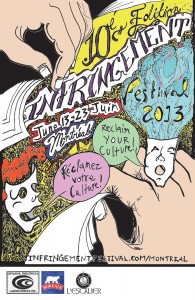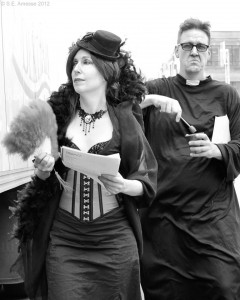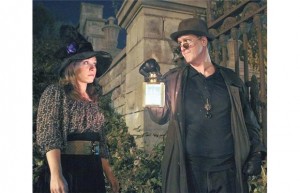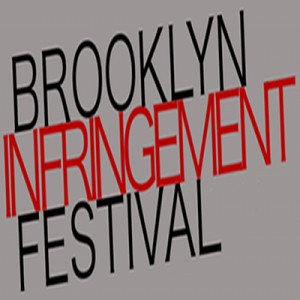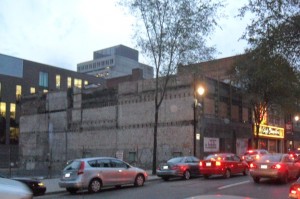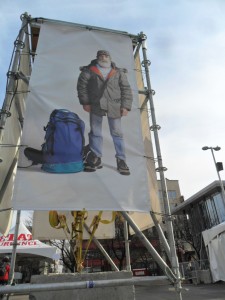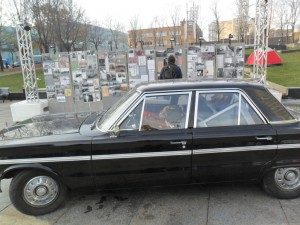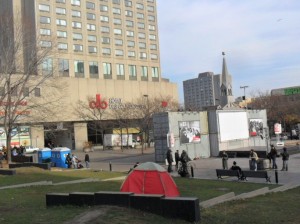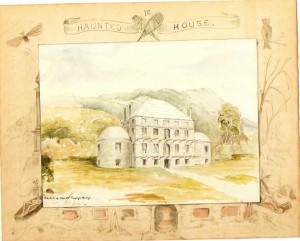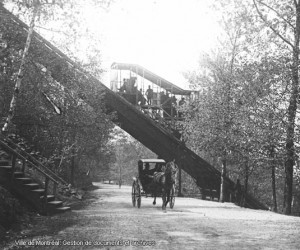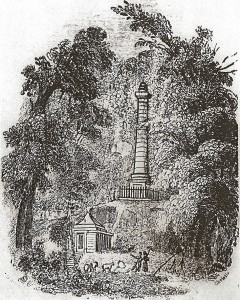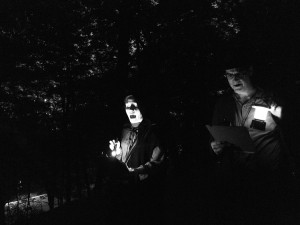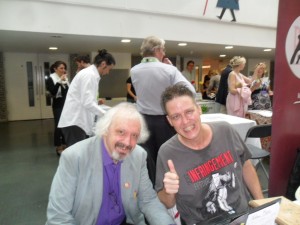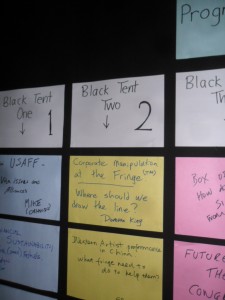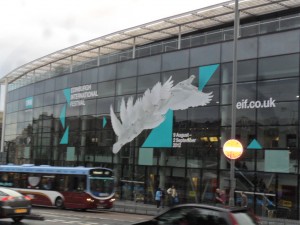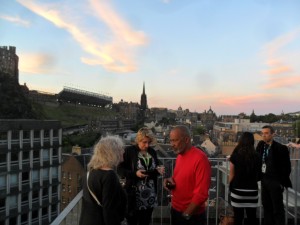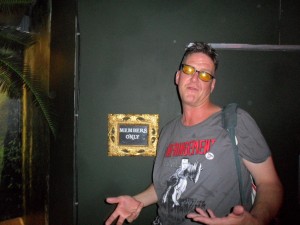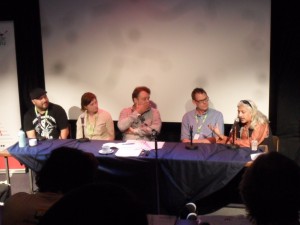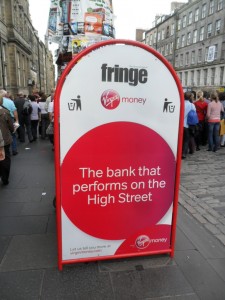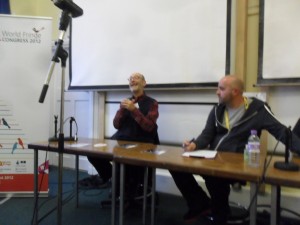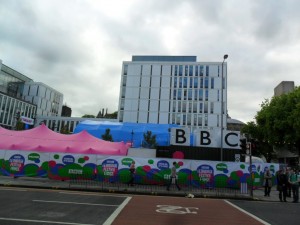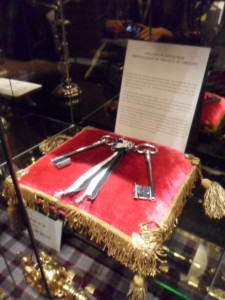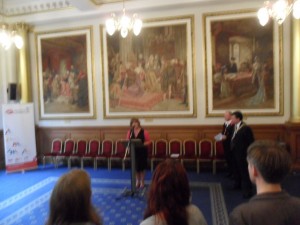Exhaustion is becoming a common theme at the World Fringe Congress, and after only 2 or 3 hours of sleep I was back at it again, blogging and getting ready for the final day. My mission, in addition to wrapping-up the Congress, was to actually get out there and see some Fringe shows to help me reflect on this whole experience.
Brunch was served at 11 am at SummerHall: bacon sandwiches, pastries, coffee and champagne. The Congress leaders, including World Festival Network’s Holly Payton-Lombardo and Edinburgh Festival Fringe Society’s Kath M Mainland, thanked us all for coming and forecast that we would be seeing each other again in the not too distant future. There is talk of holding another Congress next year at the Festival OFF d’Avignon in France. On the said topic, I had a heated discussion with Greg Germain, OFF’s president, about the meaning of Fringe-like festivals. He felt it was solely to showcase the works of artists in an arts marketplace, comparing it to an automobile show where car companies pay to display their wares in hopes of increasing sales. I disagreed, and, as we often do in francophone cultures, we had a friendly-yet-heated little argument, raising eyebrows around the room.
I also had an interesting discussion with “Dr. Fringe”, or Dr. Xela Batchelder, about the Fringe trademark in New York State. She claims that there appears to be no records of its existence, and she is apparently involved with setting up the new Niagara First-bank-sponsored Rochester Fringe. Apparently Rochester organizers contacted the cutting-edge Buffalo infringement festival to ask for advice, and Buffalo essentially hung up the phone when they heard it was a “Fringe”. It will be interesting to see what happens with the trademark, but one thing is certain: we can count on her to use her investigative powers to try and get to the bottom of things. She contacted me years ago while writing her dissertation, and the infringement festival actually made it into her work (pages 154 – 158). Although Dr. Fringe and I disagree academically about corporate manipulation at the Fringe and the idea that the Fringe is meant to be ‘edgy’ (she claims this is one of several “Fringe myths”, whereas I feel the political act of playing on the fringe of the Edinburgh International Festival after being snubbed cannot be called anything but “edgy” and political), we both share a passion for Fringe and infringement politics.
After brunch, I bid farewell to many of the Fringe employees who had been so supportive of us throughout the Congress. One of them who impressed me considerably was Naomi Wallis-Ryder, an edgy, young feminist who is enrolled in a Masters degree in Playwrighting, due to start in September. With her plans to engage in critical social commentary with “lots of swearing”, I will certainly keep an eye out for her work in the future.
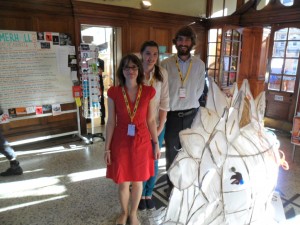
Next up was a series of media interviews: video for the Edinburgh Festival Fringe Society at SummerHall, then audio for FringeReview with Paul Levy at the Fringe Central, and finally video for Amy Wragg, who expressed interest in potentially setting up an infringement or converting her Fringe into an infringement festival.
With all the blogging and interviews finally finished, we headed off into yet another Scottish downpour to do a spot of souvenir shopping and to have a pint. Finally, with the Congress finished up, there was time to actually see some performances. We decided to start with the PBH Free Fringe.
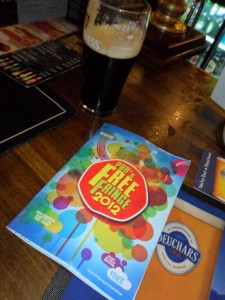
After browsing the programme, we soon entered the warren-like Banshee Labyrinth (Venue 156) for a 6:20 pm showing of Newsfedup, a spoken word show by Cat Brogan. According to the Free Fringe programme, “Cat told Alistair Campbell to shut up on live TV…and he did.”
Cat Brogan is a feisty and humourous Irish activist who acted as media spokesperson for Occupy London. She’s also a proud squatter, lesbian, and brilliant wordsmith and performer. She kept us enraptured during the hour-long performance with tales from Occupy London, police brutality and kettling, dealing with corporate media, squatting, and her various love affairs, all interspersed with hot poetry, often spoken to the rhythm of the bodhrán, or traditional Irish drum.
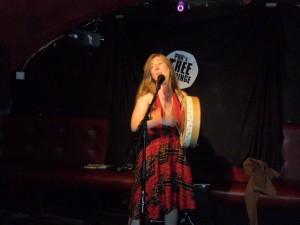
Cat concluded her brilliant performance with “Fuck the Edinburgh Fringe! Fuck the Virgin Money Fringe!”, prompting me to lead a standing ovation in that ancient nook of the midaeval labyrinth.
Finally, after days of meetings with the professional administrators who organize so-called “Fringe Festivals” around the world, I had found the real deal! To my supreme satisfaction, I had the good fortune of experiencing the true Fringe, and not the co-opted version! I hugged her and thanked her profusely for finally exposing me to what I had been seeking all along – the pure, unadulterated and unfiltered Fringe! Not only was the edge razor-sharp, but the glowing Fringe spirit was ever-present and totally undeniable. Cat Brogan did not allow her work to be compromised in any way, and that is precicesly why it signifies the real Fringe.

I passed her our information and promised to spread the good word that there still is a bright Fringe spark burning in Edinburgh, and it’s to be found at the Free Fringes and beyond.
To juxtapose, we caught an “official” Fringe show (as in, the artist paid 400 pounds to be promoted by the Edinburgh Festival Fringe Society and appear in the programme) in the basement of a pub. Without wanting to get into too much detail, the show we wanted to see was replaced with another by the same artist due to technical problems. She assured us, in a posh British accent, that the new show had received “Five stars” in important media publications. After starting rather late, the unexpected performance turned out to be painfully self-absorbed and long-winded, causing many of the six audience members to fall asleep. They were jolted awake at 9 pm, when the door opened and someone whispered: “Psst! You’ve gone over 15 minutes. There’s another show on now. Please wrap it up.”
The long-winded artist ignored the warning and continued, until 15 minutes later, a man suffering from what seemed to be cerebral palsy entered and practically begged her to finish up because he had an audience waiting to see his own performance. Shockingly, she scolded him for his interruption, barking repeatedly: “Close the door, close the door and sit down!”, despite the fact she was clearly in the wrong. The poor man, deflated, exited. The woman continued blatering on, as though she was the most important performer in the world. In Britain, apparently the trustafarian moniker is sometimes applied to people like this.
Our anger building at this blatant disrespect and discrimination, Amy and I got up and we promptly left this disgraceful scene, to the apparent shock of the actress. Outside, I apologized profusely to the artist and his audience, even though I had been merely a spectator, and told them I didn’t personally think she would be finishing any time soon. The respect or good theatrical judgement just wasn’t there. I added that should they choose an infringement festival next time around, I could guarantee that they would never receive this sort of shabby treatment.
I cannot entirely blame the Edinburgh Festival Fringe Society for this theatrical disaster, because they are “open-access” to those affluent enough to afford the 400 pound fee, and therefore had no control over the content of the drawn-out performance. However, I would have expected them to guarantee that the second show would have been able to start at the allotted time. The EFFS offers various “training programs“, so one solution might be to give artists a crash course in respecting performance times – and peers – for those who enroll.
After this most horrible of theatrical experiences, we attended one last gathering of participants from the World Fringe Congress, this time at the opulent and Old-worldly Institut français d’Écosse. Over pricey red wine and mouth-watering charcuterie platters of expensive cheeses, olives and fine meats, we said our final farewells. There were a lot of hugs, because despite the critical tone I may take towards issues of corporate manipulation at the Fringe, all of the people who organized and attended the World Fringe Congress can only be described as lovely, friendly and wonderful people. Although many of them may have disagreed with my point of view, we still got along very well as people, which means they were open-minded, communicative and at least willing to consider the issues I brought up. Some even conceded that, to them, I represented “the conscience of the Fringe”, which made me feel as though I had made my point effectively. They will all be missed.
Realizing I needed to pull an all-nighter to be at the airport at 4 am for a 6:10 flight to Paris, I went back to the Riego Street flats with Amy Wragg, who graciously allowed me to use her cellphone to book a 3 am taxi. At my door, Amy and I bid farewell one last time. Having met a kindred spirit with an undeniable edge, I realized how much I would miss her. Promising to meet again one day and wishing each other all the best, we parted our separate ways.
With about 2 hours of sleep over a 48 hour period, I arrived at Edinburgh airport on time, thoroughly exhausted from my experience at the World Fringe Congress, EFFS “Fringe”, and on the Fringe-proper.
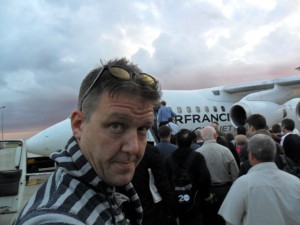
In transit-Hell, the way back to Montreal through various airports and skies, I tapped away on my laptop, reflecting on what had happened over the last few days. Did I get my message across about the need to safeguard the Fringe-proper, or is the once-ethereal Fringe doomed to be endlessly co-opted by corporate interests and overzealous administrators? Is it destined to be locked into structures that favour corporations and bureaucrats over artists, especially those who struggle just to make ends meet?
Upon finally arriving home, I turned on my computer and knew immediately that my visit had been worthwhile. Despite all the corporate interference that had kept the real Fringe separated from me most of the time during my stay, I was thrilled to discover a message from Amy Wragg on my facebook page:
Ipswich Infringement Festival (UK) coming soon… Description: Inspired by the International Infringement Movement which originated in Montreal (Canada) where the word ‘Fringe’ is trademarked we will be starting the very first UK Infringement Festival in Ipswich. Infringement Festivals seek to return the concept of ‘Fringe’ back to its roots, reinvesting the spirit of equality, rebellion, non-conformity and free access for artists without incurring censorship or fees. Not the bastardised, corporate and bland ‘pay to play’ beast that many have become. Ipswich Infringement Festival is a non-commercial, open access, ethical arts event. We will never charge a registration fee or take a percentage of your tickets sales. It will always be free for participants and supportive of critical, activist and politicised work that seeks to challenge. InfringementUK@gmail.com***
REFLECTIONS & CONSTRUCTIVE CRITICISM
My trip to the Edinburgh Fringe and the World Fringe Congress opened my eyes to various important issues related to corporate interference at the Fringe, both in Edinburgh and across the globe. Given my theory that the more corporate a Fringe becomes, the more it loses its edge and dampens its spirit, here I will list my critical observations and recommendations. Again, nothing is personal – this is about structure and arts administration, and not individual people. I hope my comments are taken as constructive and do not upset people within organizations such as the Edinburgh Festival Fringe Society (EFFS), the World Fringe Congress (WFC), or anyone else for that matter.
My first observation is that there appears to be a lack of transparency at the Fringe. To most outside observers there is no difference between the Fringe-proper (the temporal artistic/political space surrounding the Edinburgh International Festival) and the “Fringe” organized by the Edinburgh Festival Fringe Society (EFFS), whereby artists must pay 400 pounds to be in the programme and access various services.
For example, when I arrived at the airport and asked for tourist information about the Fringe, they gave me the EFFS booklet, which excluded all other performers who had not paid their 400 pound fee, including those at the Free Fringes, Forest Fringe and elsewhere. Even my first blog on the topic linked to their site for the word “Fringe”. It also appears that EFFS makes little effort in its own material, such as the thick programme it distributes with the Virgin Money logo on the front, to differentiate themselves from the Fringe-proper.
This leads to confusion, as evidenced by Cat Brogan’s curse: “Fuck the Edinburgh Fringe! Fuck the Virgin Money Fringe!” In reality, Cat Brogan was playing in the Edinburgh Fringe-proper, or the controversial political and artistic space that surrounds the corporate Edinburgh International Festival. The awkward-sounding “Fuck the Edinburgh Festival Fringe Society ‘Fringe’!” would have probably been more accurate. There is clearly a problem of perception as to what the Fringe actually is, and that problem may lie in the EFFS being somewhat disingenuous via the information they distribute and the promotional activities they partake in.
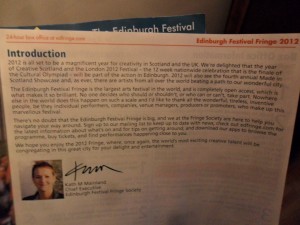
The introduction to the EFFS programme makes no effort to differentiate the EFFS “Fringe” from the Fringe-proper, suggesting a sly attempt to equate the EFFS with the totality of the Fringe, which is very misleading and likely the source of the confusion. This results in spectators assuming the EFFS programme is indeed representative of the Fringe-proper, causing them to miss out on the arguably more cutting-edge performances at the Free Fringes and beyond. Those considering playing on the Fringe are steered towards the EFFS model in their guidebooks, which do contain excellent information. It is also possile to find out that EFFS is only a service-providing organinzation, if one digs deeply enough.
In all fairness, administrators at the EFFS do acknowledge their true status, albeit mostly in secondary materials. In an interview in The Edinburgh Fringe Survival Guide, Kath M Mainland states on page 38: “If we are essentially a service organization then we’re only as useful as the services we provide…They need to be the right services in order for people to use us. For the broad majority of people coming here, they do need those services. If people don’t want those services, we shouldn’t be protectionist about it.”
The misconception that the EFFS “Fringe” = Edinburgh Fringe has certainly multiplied over the years, making it one of the foremost artistic myths in Edinburgh. Even authorities on the “Fringe Festival” nowadays, such as Dr. Fringe, Mark Fisher and the authors at the EFFS materials, tend to bolster this myth in their writing, paying only lip service to the idea of the authentic Fringe. Their well-researched and intelligent publications all demonstrate both talent at writing and a passion for the EFFS “Fringe” (which they all essentially call “Edinburgh Fringe”). The impression is ingrained that the Fringe-proper, the temporal artistic space and attitude outside the mainstream arts, is the same thing as the EFFS “Fringe”, which simply isn’t true.
One solution would be for the EFFS to be totally honest and transparent about their limited role in the Fringe eco-system in the materials they create, especially in introductory messages, both online and in hardcopy. They could also launch an education campaign to clear up this misconception at the Tourism Office, amongst festival-goers and elsewhere.
The idea that the EFFS “Fringe” is “open-access” is also somewhat misleading, because artists usually need to fall into a certain upper or middle-class financial demographic to participate with the 400 pound fee. The sad reality is that many artists, especially the important critical ones like Cat Brogan, simply don’t have 400 pounds ($625 Canadian) to spare. In Montreal, for many artists, that is the equivalent of more than a month’s rent.
EFFS was originally created in 1959 with a mission to run a cental box office, organise a club where participants could socialize and to publish a programme of “everything that was not in the Internationl Festival” according to author Mark Fisher in The Edinburgh Fringe Survival Guide (page 21). Despite this noble-sounding objective, they charged 10 pounds to join (11 for newcomers) as a fee that “guaranteed inclusion in the published programme.” The contradiction lies in the fact that they did not publish “everything” outside the International Festival, but rather only those who could afford the fee and agreed with the structure.
In order to be inclusive, one solution would be for EFFS (or some other, more neutral entity) to create a low-cost web version of the programme that accepts information from everyone playing on the Fringe-proper, and not just those wealthy enough to afford a 400 pound entry fee at the EFFS. This website should be frequently updated in order to be as inclusive as possible. For example, at the Montreal infringement festival an inspired artist can create a performance or work of art on the spot and have it placed online as soon as feasilbly possible. There is no reason EFFS could not provide the same service with their vast resources, unless they have a vested interest in keeping the EFFS “Fringe” exclusive only for artists with 400 pounds to spare.
Secondly, I observed that there was a lot of visual pollution and corporate spam from unethical corporations (Virgin Money, Deuchars beer, etc.) that compromised the integrity of performance spaces and artists in areas such as the Royal Mile. Dr. Fringe briefly touches on this issue on page 143 of her dissertation: “If done cautiously, [corporate sponsorship] does not have to be a bad thing; the problem comes when a fringe or a venue mistakes a brewery or other sponsor for their customer.”
While this cursory point is a good place to start, it is clear that there are many more integrity issues that need to be examined as well. Whether we like it or not, playing tradtional Shakespeare in a McDonald’s restaurant will compromise the performance by associating it with plastic, fast food and a creepy corporate clown.
While normally performers get paid to be associated with corporate advertising, at the EFFS “Fringe” this dynamic is reversed and artists must pay to be attached to unethical corporations. For the average festival-goer, it appears that Virgin Money is somehow running the Fringe Festival at certain locations (The Royal Mile) whereas Duchars beer is advertised on most venues. Again, while Virgin Money may not actually run the EFFS “Fringe”, the illusion is there, prompting activist-artists like Cat Brogan to declare “Fuck the Virgin Money Fringe!”
Christabel Anderson, Head of Participant Services at the EFFS, explained that Virgin Money’s sponsorship pays for “infrastructure” for buskers on the Royal Mile.

The most visible “infrastructure” includes rubbish bins cloaked in advertising and giant gateways advertising the unethical bank. One solution would be to scrap the sponsor and its visual pollution and simply allow buskers to play on the unadulterated street, as they are accustomed to in most cities. Given that unethical sponsorship also causes serious brand damage to the Fringe, the EFFS would be wise to consider using the infringement festival’s Ethical Sponsorship Criteria to minimize the damage (if sponsors are actually needed at all). One problem with unethical sponsorship and visual pollution is that it not only damages the brand of the EFFS “Fringe”, but also the Fringe-proper, causing a loss of agency amongst artists and their work and disempowering the Fringe movement by creating the illusion it has been co-opted by corporate interests.
I must stress that I really liked all the people I met on the EFFS team, and I hope my criticism is taken well. I was a bit shocked, while reading Dr. Fringe’s dissertation, that critical artists in the past were not well-received for expressing their own feedback. In 1987, artists in Edinburgh created a “Fringe Fringe” because they felt the EFFS Fringe was “no longer a Fringe”. They claimed: “It has become a piece of bureaucratic machinery which exercises a stranglehold over all publicity by the production of an official Fringe Programme…”
While EFFS went into PR-mode to try and smooth over the ruffled feathers in the mainstream media, behind the scenes some administrators were livid. Dr. Fringe printed some of the vitriol on page 147 and 148 of her dissertation. One board member accused “Fringe Fringe” artists as being “crassly insensitive, egregiously childish, thoroughly idiotic, and revelatory of the most absurd form of self-satisfaction.” The idea that others beyond the EFFS could operate at the Edinburgh Fringe was too much, prompting the angry cultural gatekeeper to mock the independent artists: “I think [Fringe Fringe] got involved on a I-can-do-that-too-Daddy-it’s-quite-easy-to-drive-a-car-I’ve-often-seen-you-do-it level…”
When the infringement festival was founded in Montreal, the vitriol we heard was not dissimilar. Every effort was made to discredit the independent artists instead of listening to their message. Insulting comments like these demonstrate an inabillity to listen to criticism and signify cultural-gatekeeper-frustration at legitimate artists challenging the unequitable status quo.
It’s beyond silly, because the fact is artists are fully capable of running an authentic Fringe without any dodgy corporate involvement or “professional” arts administrators, as the infringement festival has been doing for nine years now in Montreal. Infringement festivals now operate in five cities, in three countries, and the infringement model of running the equivalent of a “Fringe” festival has proven itself as both fully inclusive and sustainable. The reward comes, not from fiecre competition and bitter rivalry, but from the artistic solidarity that is generated in the community and the independent, critical and transformative space that is created.
Essentially, when organizations begin offering better services, access, and Fringe branding to artists with money, it disadvantages other artists not playing within the same structure and causes animosity amongst independent artists. The result, for them, is a draining of audience members, media, and Fringe recognition to a more privileged class of artists. It creates a two-tier system, which leads to a splintering of the authentic Fringe-proper.
Ideally, arts administrators should strive to be inclusive of the entire community and support the authentic Fringe ideal. The fact is the Edinburgh Fringe, and most Fringes around the world are largely run by volunteers, with comparatively few paid administrators on board. It is the people and the artists who should be calling the shots at the Fringe, and not bickering arts administrators in a constant power struggle over the Fringe brand.
Moving on the World Fringe Congress, my first point is that it was a brilliant idea to assemble all the so-called “Fringe” festivals around the world for a Congress to share thoughts and ideas. I am forver indebted to organizers Holly Payton-Lombardo and Cath Mattos, two women I admire very much, for inviting me, despite representing infringement festivals, which are often described as being the antithesis of the corporate Fringes. When I was first invited I expressed fear that this might just be some sort of PR exercise, but they assured me my point-of-view would be welcome. They were right.
Even though I was not afforded the opportunity to present my opinion formally, as was the case with other delegates invited onto panels, I was able to spread my message through questions to panelists, in Break Out Sessions, Open Spaces and at the World Fringe Fair. Even though I would have loved to debate Barclay Price, British Parliamentary-style, I was satisfied that I could communicate freely and that my message wasn’t censored. I was also made to feel extremely welcome – and even important. As such, I can conclude that Holly and Cath are brilliant people whose hearts are definitely in the right place.
To offer some constructive criticism, I feel that that there was not enough critical thinking put into organizing the event, which resulted in an emphasis on delegates looking mainly at business issues, such as acquiring money and the “best” financial structures for organizing “Fringe” festivals. There was little or no talk about the history of the Fringe or what defines it in contemporary terms (eg: the edge and spirit), nor was there any formal critical analysis about the relationship between so-called “Fringe” festivals and administrators and corporations.
Indeed, Holly argued that there was no right or wrong way to do a Fringe, and she even defended the CAFF model whereby the word “Fringe” is trademarked, making the festivals exclusive. The contradiction lies in the WFC’s praise of Fringe Festivals for being “open-access” when they simultaneously supporte festivals, such as those in the CAFF model, that close access and become exclusive. Simply put, you can’t have it both ways, and that was one of the messages I tried to get across. My message must have sunk in, because following the Congress, the WFC issued a statement that did not include the word “open-access”:
‘The inaugural World Fringe Congress took place in Edinburgh between 16th and 19th August 2012. We met to exchange ideas and experiences and we have discovered that within the huge variety of models and philosophies, there is much we have in common.
Each Fringe is unique and is responsive to its own local environment and community. What binds us together is our commitment to a Fringe ideal and our belief in its importance and impact for artists and audiences.We are proud to have created a new network and strengthened the Fringe family.”
The statement is vague enough to allow for the sort of corporate manipulation that I have argued damages the Fringe’s image, dulls the edge end extinguishes the spirit. What is stopping a corporation like British Petroleum, in need of brand-repair, from buying off Fringe administrators and attaching its brand to the Fringe? While Holly suggests in the New York Times that “Fringes are born of passion and no money and hard work,” it is arguable that quite the opposite trend is now happening. New Fringe Festivals sprout up every week, many of them using a business model, and older, more established Fringes are beginning to sell out to corporate interests.
The problem lies in the ambiguity of “a Fringe ideal,” and having listened to delegates from across the world and read the work of Dr. Fringe, I can attest to the fact that there are many different ways in which “a Fringe ideal” has been defined.
While I argue that the Fringe is meant to be an independent, controversial, and politically-charged space where artists are empowered, as was the original in 1947 version, I have heard other perspectives that paint is as an “arts market,” “artistic frat party,” a “marketable brand,” and even a “marketing strategy.” One delegate explained his business model to me: he created both a traditional arts festival and a “Fringe” in order to double his profits.
My point is this: if the Fringe can be anything to anyone, what differentiates it from anything else?
Even Dr. Fringe takes issue, claiming on page 5 of her dissertation that “Recent decades have seen the spread in numbers and influence of other arts festivals calling themselves ‘fringes’. The non-Edinburgh regional festivals, or NERFs, often little resemble their namesake. Many scarcely have more in common with the original than the use of the term “fringe,” yet all look in some way to Edinburgh as their model or inspiration.”
She is speaking, of course, about “Fringe” Festivals around the world that do things differently. Some curate works they consider “Fringe”, some are run as businesses, and some even pay artists to play. The one common denominator between all the NERFs and the EFFS “Fringe” is that while they all present the illusion of being inclusive, none of them actually offers full “open-access”, or accepting all applicants into the festival, regardless of financial situation or talent. Unfortunately, I learned that even the PBH Free Fringe in Edinburgh has a limited number of slots and therefore cannot accomodate all of the artists wishing to perform, instead curating edgy and underground performers who “are good enough, will work as part of a team and contribute in non-money ways.”
The result in Edinburgh is the bloated EFFS structure that appears to almost monopolize the Fringe brand, with several smaller festivals and artists rebelling and/or remodelling, like the Free Fringes, indy artists and newer ventures like the Forest Fringe. Simply put, it’s a Darwinian mess at an event that could easily accommodate all points of view under one Fringe umbrella. Solidarity is not difficult and the results speak for themselves: at the infringement festivals, for example, nobody is turned away and everyone has equal access.
The disputes in Edinburgh, largely based on financing and issues of exclusion, paint the Fringe in a bad light. It makes it appear as though artists in the “cultural capital” cannot work in solidarity, let alone even agree to share the Fringe-proper in an equitable way. Again, a way needs to be found to include everyone playing on the Fringe-proper, such as a website, if there is to be any hope of inclusion and open-access at the Edinburgh Fringe.
I also have some constructive comments to the delegates of the World Fringe Congress, many of whom described their motivations, intentions and opinions throughout the Congress. This advice also extends to other “Fringe” festivals across the globe and to those considering starting one:
DON’T BE A CULTURAL GATEKEEPER.
The real Fringe is signified by pure open-access and total independence – there are no arts administrators or cultural gatekeepers. Anyone can play and nobody can be kicked out.
Even if many of the “Fringes” around the world adhere to questionable structures that keep their brand of “Fringe” out-of-reach of many artists, I recommend, like I do to EFFS, that they take a leadership role in being transparent and in empowering the real Fringe by embracing, instead of trying to censor it. There must be room at all of these so-called “Fringe” festivals for artists playing on the Fringe-proper, or that magical temporal space where artists have independence to do anything they wish without cost or interference. Otherwise, the act of calling it a “Fringe” Festival is disingenuous, more of a branding strategy than a nod to an actual artistic movement.
My final observation is about the Fringe, infringement, and politics. Late capitalist society offers many contradictions brought on by corporate ideologies and the attempt to transform almost everything into a profitable commodity. The term “Fringe” implies a space where the status quo is challenged and social change is possible, hence the term “a radical fringe party” in governmental discourse.
Simply put, co-opting the Fringe for corporate reasons neuters the original concept. In Canada, where the word Fringe is literally trademarked, it is mockilngly called the FringeTM. Like McHealth Food, it’s a blatantly obvious contradiction that has the devastating effect of subverting the original concept, for financial purposes, of course. It’s more than creepy to think that a small segment of businesspeople and administrators can get away with this act of co-opting so easily, essentially stealing something that was built on the work of hard-working and well-intentioned artists.
Is this the future of the Fringe? Sadly, with no voluntary regulations or even attempts to reach consensus about the Fringe’s future, it appears as though it may be impossible to save it from total corporate takeover at this point.
If the increasingly-corporate “Fringes” cannot accept the existence of the independent Fringe-proper, if they cannot agree on how to protect the Fringe from being co-opted and if they cannot even agree on an understanding of the word’s meaning, I fear it may be far too late for the “Fringe” to take on any sort of meaningful role in an increasingly critical, angry and rebellious society.
What is needed in the 21st century is a Fringe that is edgy, independent, and willing to tackle the society’s most pressing issues by providing a platform for artistic inclusion, critical thinking and radical performances. The arts can be used as a weapon against injustice, oppression and exclusion, but the late capitalist society has essentially put the Fringe-proper onto the cultural endangered species list. Could it be time for administrations to reform it or for artists to take it back, or is it already too late for that?
Thankfully, if the Fringe becomes totally unsalvageable, we can all rest assured.
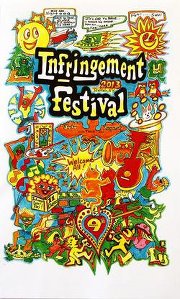
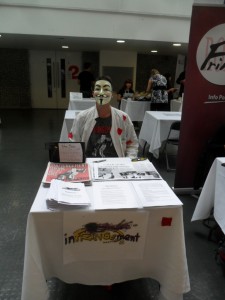
![carstorieslogo1[1]](https://optative.net/blog/wp-content/uploads/2013/06/carstorieslogo11.jpg)
